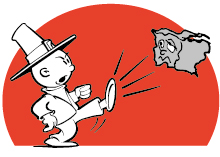| No Packaging Awards for 2018 |
|
None of the drug packaging examined in 2018 met all the safety and quality standards required to earn a Prescrire Packaging Award.
Our evaluations of drug packaging in 2018 revealed a string of flaws and dangers, as illustrated by the 25 products that received a Red or Yellow Card.
|
 Packaging Packaging
Yellow Cards
|
|
Vicks vaporub° ointment (camphor + eucalyptus oil + levomenthol + thymol + turpentine oil) Procter & Gamble Pharmaceuticals (Rev Prescrire n° 417)
 For marketing an ointment containing concentrated terpenes, which can cause seizures and allergies, in a jar. A packaging going against the prevention of misuse, some cases of which were reported. This packaging exposes patients to a large quantity or cosmetic type application (application on the eyelids, face). For marketing an ointment containing concentrated terpenes, which can cause seizures and allergies, in a jar. A packaging going against the prevention of misuse, some cases of which were reported. This packaging exposes patients to a large quantity or cosmetic type application (application on the eyelids, face).
Absent or indistinct INNs. Every year, we see so many examples of drug labelling that fails to give due prominence to the drug’s true name, its international nonproprietary name (INN), that it would be difficult to mention them all. This packaging flaw makes it difficult for users to identify the active substance or substances. Examples include Efferalgan° orodispersible tablets, Dolko° oral solution, Apaisylgel° , Sédermyl° cream, and Vicks vaporub° .
Androgel° gel in a multidose bottle with a metering pump (testosterone) Besins International (Rev Prescrire n° 415).
For not displaying the INN sufficiently clearly on the box and the bottle, which trivialises the dangers particularly in situations of chronic overdose, especially since other aspects of its packaging (its pharmaceutical form, the bottles' appearance) are more reminiscent of a cosmetic product.
Softacort° eye drops in single-dose containers (hydrocortisone) Théa (Rev Prescrire n° 418).
For not displaying the INN at all on the single-dose containers.
Trovolol° tablets (penicillamine) X.O (Rev Prescrire n° 418).
For not displaying the INN sufficiently clearly on the (non-unit-dose) blister packs.
Femi° tablets (ethinylestradiol + norgestimate) Effik (Rev Prescrire n° 422).
For not displaying the INN sufficiently clearly on the box and blister packs, or in the patient leaflet, where the brand name is over-represented.
|
 Packaging Packaging
Red Cards |
 Packaging and dose preparation errors Packaging and dose preparation errors |
|
 When a drug's indications have been extended to include paediatric use, failure to adapt the packaging accordingly poses a risk to children, in particular the risk of errors during dose preparation. When a drug's indications have been extended to include paediatric use, failure to adapt the packaging accordingly poses a risk to children, in particular the risk of errors during dose preparation.
Vimpat° 10 mg/ml syrup (lacosamide) UCB Pharma (Rev Prescrire n° 414).
For providing two different dosing devices in the box (a syringe and a measuring cup) without specifying the corresponding child's weight on each device; and because the dosing devices are graduated in millilitres, thus requiring users to convert the number of milligrams prescribed into the number of millilitres to measure, with a consequent risk of calculation errors.
Renvela° powder for oral suspension in 2.4 g sachets (sevelamer) Genzyme (Prescrire Int n° 193).
For not supplying a dosing device in the box to prepare the doses recommended for children, for not marketing lower dose strengths even though they have been authorised in France, and because a 0.4 g dose strength has not been authorised, even though this dose is recommended for certain children in the European summary of product characteristics (SPC). Inadequate packaging also exposed adults to the risk of dosing errors.
Tresiba° 200 units/ml solution for injection in a pre-filled pen (insulin degludec) Novo Nordisk (Prescrire Int n° 202).
For the fact that each graduation of the pre-filled pen corresponds to 2 units of insulin. The pen can only be used to deliver an even number of units, which is problematic for patients choosing to dial in an odd number of units. As with the other insulin pens on the French market, the pen makes a clicking sound with each dose step, which is useful for visually impaired patients, but each click up on the Tresiba° pen adds 2 units of insulin to the dose, instead of 1 unit with other pens. Both of these problems can cause errors when
preparing the dose.
A 313° 50 000 international units, soft capsules (vitamin A) Pharma Développement (Rev Prescrire n° 412).
For marketing such a large number of capsules (30) in a bulk bottle, when the dose stated in the French summary of product characteristics (SPC) is only 1 to 2 capsules every 10 days. This could confuse patients, resulting in dosing frequency errors and the potentially serious risk of chronic overdose (a).
a- The firm Pharma Développement has already informed us that it is improving its packaging and plans to market this drug in a blister pack containing six capsules. We will announce this development when it materialises.
|
 Packaging that poses a risk of poisoning children Packaging that poses a risk of poisoning children |
|
A 313° soft capsules (vitamin A) Pharma Développement (Rev Prescrire n° 412); Dolko° oral solution (paracetamol) Therabel Lucien Pharma; Efferalgan° orodispersible tablets (paracetamol) UPSA; Fluconazole Arrow° , Fluconazole Biogaran° , Fluconazole EG° , Fluconazole Mylan° , Fluconazole Sandoz° , Fluconazole Teva° , Fluconazole Zentiva° , powders for oral suspension (fluconazole) (Rev Prescrire n° 419) ; Fluoxétine Biogaran° , Prozac° , oral solutions (fluoxetine) Lilly (Rev Prescrire n° 416); Mucoplexil° syrup (carbocisteine) Sanofi Aventis (Rev Prescrire n° 414); Panfurex° oral suspension (nifuroxazide) Bouchara Recordati (Rev Prescrire n° 412); Théralène° syrup (alimemazine) X.O (Rev Prescrire n° 415, 421)
For the absence of a child-proof cap on the bottles of these 15 medicines. The caps used on the bottles do not sufficiently protect children from the adverse and toxic effects of the drugs they contain in a situation where a child gains access to the medicine without their carers' knowledge and is tempted to taste or ingest the contents.
|
 Umbrella brands: still not banned! Umbrella brands: still not banned!
|
|
Apaisylgel° cutaneous gel (isothipendyl) Merck Médication Familiale (Rev Prescrire n° 411); Sédermyl° cream (isothipendyl) Cooper (Rev Prescrire n° 411), Mucoplexil° syrup (carbocisteine) Sanofi Aventis (Rev Prescrire n° 414).
The principle of an umbrella brand is to sell various medicines containing different active substances, with different harms, under the same brand name. For example, the brand name Apaisyl° is used for: BabyApaisyl Soin Après Piqûre° a topical cosmetic product, CortApaisyl° containing hydrocortisone, Apaisylgel° containing isothipendyl, and others.
This marketing strategy, which capitalises on a well-known brand name, displayed prominently on the labelling to attract the consumer's eye and make the products easier to recognise, can cause confusion between products, and unawareness of the dangers posed by the active substances they contain, such as interactions with other drugs.
The resemblance between their labelling serves to enhance brand recognition. It also increases the likelihood of confusion between products of the same umbrella brand, by emphasising the umbrella name through the use of large, bold, eye-catching lettering, and other shared graphic elements (logos, illustrations). Meanwhile, INNs are often barely readable.
Some companies create an umbrella brand by incorporating a brand segment into the individual brand names, such as "plexil" in Toplexil° (oxomemazine) and Mucoplexil° (carbocisteine), and by using the same graphics on the products' boxes and bottles, in this case a swirl of yellow syrup.
As of early 2019, umbrella brands are still not banned in France, yet the French Health Products Agency (ANSM), has acknowledged their dangers.
|
|
About the 2018 Prescrire Packaging Awards
Prescrire's systematic reviews of drugs include evaluation of their packaging. Does the packaging make the drug easy to use? Does it constitute a therapeutic advance or is it inferior to existing alternatives? Does it pose a danger to patients?
Our packaging evaluation takes many factors into account: the situation in which the drug will be used; the patients likely to receive it, especially children, pregnant women or elderly patients; whether it will be used in an emergency, hospital or community setting, obtained on prescription, on the advice of a community pharmacist, or bought on the patient's own initiative from a pharmacy or an internet retailer; whether or not a nurse will prepare and administer it.
Every aspect of the packaging is examined to determine its quality and safety. We examine: whether international nonproprietary names (INNs) are legible and not overshadowed by the promotional components of the drug's labelling (brand name, brand graphics, logos, fanciful illustrations); whether different dose strengths of the same product are clearly marked and easily distinguishable; the clarity of any information presented graphically, such as dosing schedules and pictograms; the presence and quality of dosing devices required to prepare and administer the drug; the risk that children will be able to access the drug unnoticed by their carers; and the quality and clarity of the information provided in the patient leaflet on dose preparation, adverse effects, and the situations and patient groups in which the drug poses a risk.
Our Packaging Awards are based on independent evaluations conducted by the Editorial Staff and its Packaging working group, free from any influence from manufacturers.
No Packaging Awards for 2018, but a variety of dangers to avoid
None of the drug packaging examined in 2018 met all the safety and quality standards required to earn a Prescrire Packaging Award.
Our evaluations of drug packaging in 2018 revealed a string of flaws and dangers, as illustrated by the 25 products that received a Red or Yellow Card. In too many cases, rather than prioritising the information required to use the medicine properly and prevent errors (INN and dose strength), this information was overshadowed on the labelling by the brand name and logos. Too many medicines are manufactured without due attention to their administration, to how users should prepare the dose (very few are marketed in unit-dose containers, some lack a device for preparing paediatric doses). Most medicines lack sufficient measures to protect children from poisoning. Some package leaflets omit information that is important for patient safety. All of these points should be addressed to ensure that medicines are safe and easy for patients to use.
|
